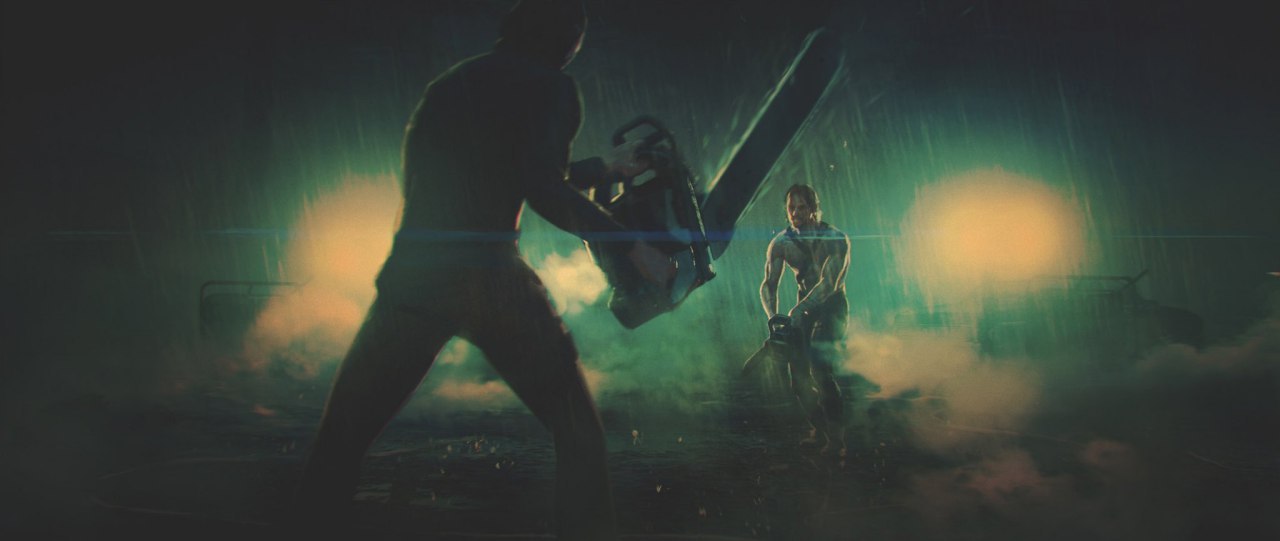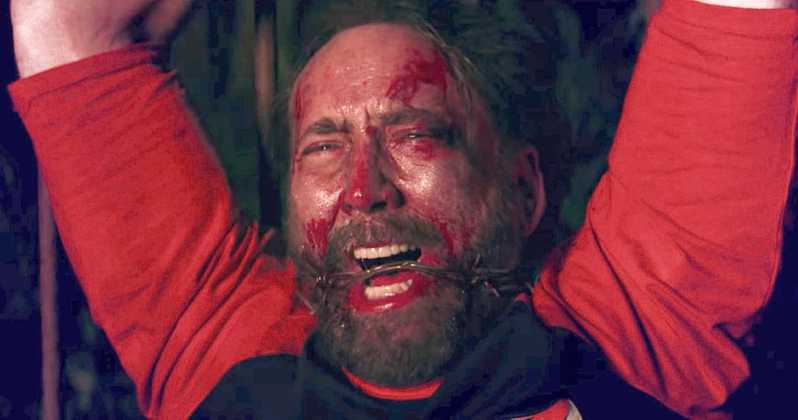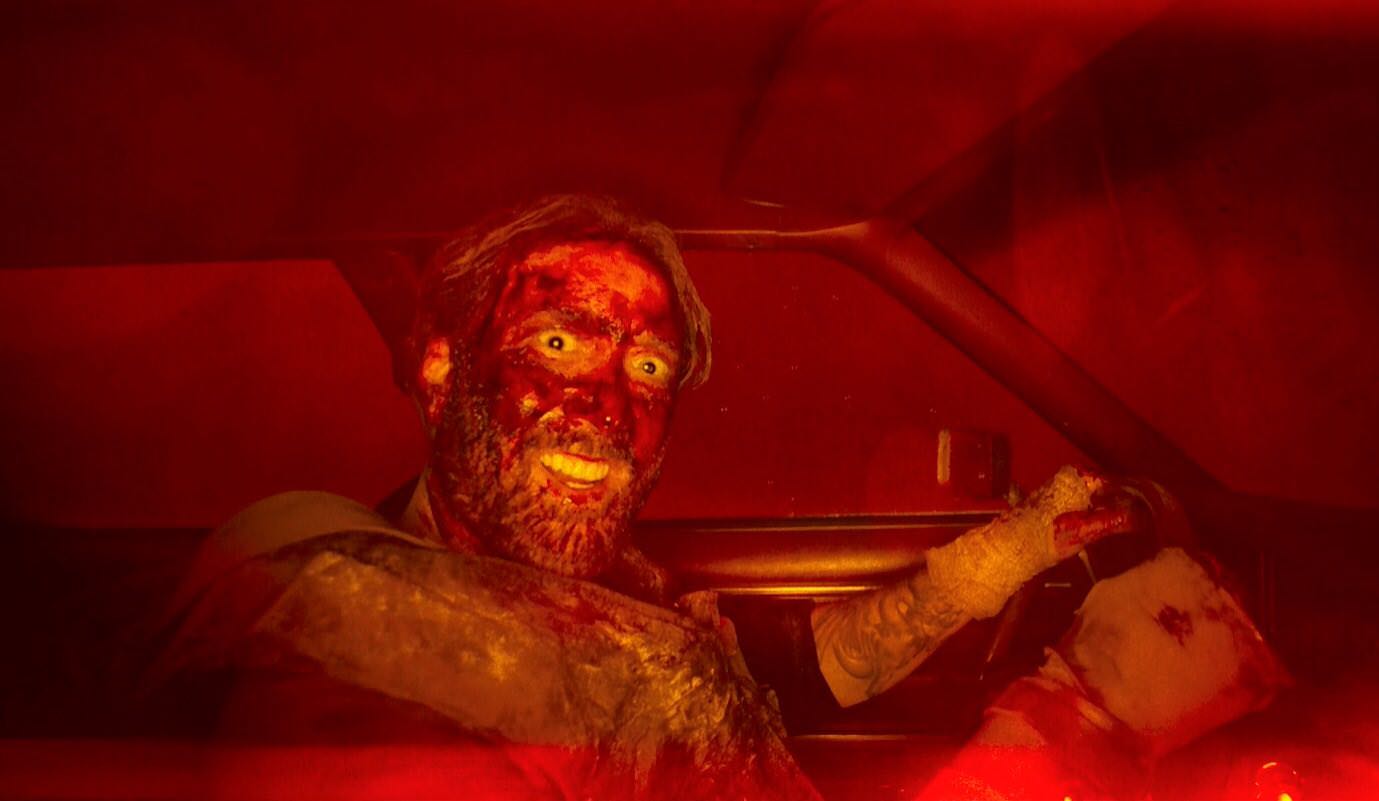Scalding Hot Takes: Mandy (2018)
Welcome to the latest entry in Scalding Hot Takes. It’s the column where I wade wearily once again into the world of film criticism by seeing and writing about the biggest and most important films of the day just after their theatrical release. Mandy is an exception in that I very much intended to write about it upon its VOD and theatrical release but for some reason never got around to doing so.
All I really knew about Mandy was that it was a crazy-ass cult movie starring Nicolas Cage involving a chainsaw fight. That’s all I needed to know. I was hooked. Incidentally, I wouldn’t be surprised if so many garage bands found the name Nicolas Cage Chainsaw Fight so irresistible that sometimes multiple shitty rock combos with that moniker get confusingly booked on the same house party bill.
Some movies gradually develop cults over time and some movies angrily demand to be adored and worshipped as cult classics from their moment of conception, a phenomenon I have deemed Snakes On a Plane Syndrome in the past. Mandy belongs in the second category. It’s designed to be shown only at midnight in funky repertory houses to drunk and/or stoned audiences with a nuanced appreciation and understanding of bad movies in general and the the FILMS of Nicolas Cage in particular.
Now I ended up seeing Mandy stone-cold sober at ten o’clock on a Monday morning so that I could talk about it for my podcast. If ever there was a movie that demanded to be seen by stoned audiences late at night, it’s Mandy. It’s only slightly less of a stoner movie than the films of Cheech and Chong. I enjoy taking drugs and watching movies and watching movies while high so I felt like I was betraying both drugs and Mandy by seeing the film straight. It’s a testament, however, to how trippy the film is that I felt like I was stoned out of my gourd watching it even though I had nothing more potent than caffeine in my system.
Mandy makes no sense outside the context of cult cinema, of b-movies, of crazy camp sensations made not for the mainstream or a mass audience but rather for a feverish subsection of devoted acolytes and b-movie evangelists for whom the movie’s star is a God. A shaggy, grizzled, half-mad and wildly uneven God, to be sure, but a god of trash culture and B-movies all the same.
Cage brings a world of pain, history and hurt to the role of Red Miller, a logger in “1983 A.D” whose humble life revolves around his job and his life with his spooky, bookworm girlfriend Mandy (Andrea Riseborough), a deeply damaged, spooky eccentric on a spiritual and emotional wavelength only her loving partner seems to share and understand.
They’re two weirdos that found each other in a brutal world whose happiness is shattered when she comes to the attention of Jeremiah Sand (Linus Roache), the leader of the sinister Children of the New Dawn cult.
Now I have a problem watching movies like this. I’m so suggestible and easily led that whenever I see a movie about a charismatic cult leader I’m instantly ready to join their cause and follow them to the depths of hell with my whole soul and all of my financial resources when it almost invariably turns out that
The cult I was so eager to join is, in fact, evil.
It’s a murder/sex/acid/power cult, and not one of the good, true, legitimate ones either.
Vibe-wise, Mandy is a crazy cult movie on acid, MAN. That’s only partially because it is quite literally a crazy cult movie on acid in that its plot is about crazy cultists on LSD and it is a movie.
Jeremiah has Mandy dosed with brain-meltingly powerful acid and, in full of view of his worshipful, dead-eyed, drug-addled followers, attempts to seduce Mandy with a hypnotically creepy monologue recounting his peculiar, decidedly familiar origin story as a failed musician and entertainer who finally realized his true identity and destiny as a man-God who can and must take everything in the world that he wants and desires as his rightful due.
Jeremiah plays a trippy, spacey song as part of his failed spiritual and sexual seduction attempt, the kind you can easily imagine someone like Charles Manson writing that impresses the title character even less than his naked penis does.
Mandy laughs in the face of a man used to being treated like a dark deity. His monstrously large, fragile ego battered, his masculinity insulted, he lashes out in murderous vengeance and has her murdered in the most ominously metal manner imaginable.
As much as I love this scene, I would have loved it even more if the sinister cult leader had put on his music and instead of bleary psychedelia it played “MMMBop” and Mandy earnestly responded, “Well, it’s SUPER catchy and all but I’m not really sure what, if anything, about it means that I should have sex with you and become one of your followers.”
Name a more iconic duo.
When Mandy is murdered the movie shifts gears from arty, psychedelic psychological horror to blood-splattered, revenge-fueled action. Mandy was written and directed by Panos Cosmatos. When I watched Mandy, I knew him only as an art-house auteur whose 2010 debut, Beyond the Black Rainbow had attracted a sizable cult audience. It wasn’t until I looked him up online that I realized that Panos is the progeny of George Cosmatos, the director of such popcorn classics as Tombstone, Rambo: First Blood Part 2 and, most excitingly as far as I’m concerned, the 1986 Sylvester Stallone masterpiece Cobra.
Then everything clicked into place and I realized that Mandy is in many ways a batshit crazy arthouse/grindhouse/museum remake of Cobra. Both movies are about stoic, heavily armed men of violence who launch a one-man war on a murder gang so unrelentingly, unforgivably evil that they angrily demand to be murdered en masse, not brought to the attention of law enforcement.
The difference is that Cobra turned out so lurid, intense and over the top (not unlike another Sylvester Stallone film from the period, Rhinestone) that it bordered on avant-garde pop art. Mandy, on the other hand, very nakedly sets out to be art. In its simultaneous devotion to both vulgar trash and high art, Mandy reminded me a lot of the film of Nicholas Winding-Refn.
He has fun.
That makes sense, since Winding-Refn is a big Cobra fan, to the point of having Ryan Gosling chew on a matchstick in Drive in homage to Stallone in Cobra. Circles within circles, man!
Mandy is the only movie I can think of that would feel equally at home as an installation in an art museum and as a massive mural airbrushed on the side of a stoner metalhead’s sweet-ass van in 1978.
Mandy is heavy metal in its themes but also in the sense of the wicked-ass weapon Red forges out of steel and fire and pure hatred so that he can enact revenge on the monsters who took from him the only thing he loved.
The sword Red makes reminds me a lot of a similar sword by brother made for me a few years ago and then presented to my in-laws because I was out with my wife and baby strawberry-picking. It was a great homemade sword, easily the finest I’d ever been given or laid eyes upon but I had couldn’t store a murder weapon like that in my home or anywhere my baby could get to it.
No, a sword like that requires a special occasion. If, God forbid, an acid-damaged murder sex gang were to murder my family and then set them ablaze and I somehow survived, the first thing I would do, after taking a few weeks to recover psychologically from the trauma, would be to collect my brother’s homemade sword so that I could use it to murder all of the people responsible for my family’s brutal massacre.
Mandy doesn’t just feel like a movie that belongs in the Museum of Modern Art and the side of some sketchy stoner’s van: its structure also reminded me throughout of a video game, particularly one of those fighting games where you pick up or build various weapons (like, for example, a wicked-ass sword-like murder machine or chainsaw) as you take on various bad guys en route to a final stage where you battle Big Baddie.
Cosmatos initially sought out Cage for the flashier role of Jeremiah but Cage was uninterested. The Academy Award-winner would have done a fantastic job as the movie’s weaselly answer to Charles Manson but Roache is mesmerizing in the role, creating an unforgettable villain at once hypnotic in his charisma and quivering intensity but pathetic and weak underneath, a charlatan who keeps his followers docile and drugged up so that they’ll never see him for the sad, desperate and unhinged man he truly is, only the God he pretends to be.
Art infects and elevates every element of the film. Damn near every frame could be exhibited in art gallery. It’s a film of soft pinks and dreamy blues full of long takes that ratchet up the intensity to sometimes unbearable levels.
Mandy promises to be a balls to the wall cult movie mind-fuck for the ages. It delivers.
I make my living primarily through Patreon, so if you would consider pledging as little as a dollar over at https://www.patreon.com/nathanrabinshappyplace it’d be









